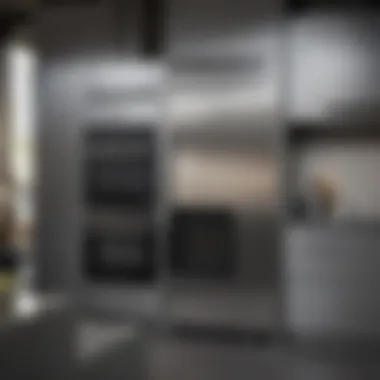Mastering the Art of Cleaning Brushed Stainless Steel


Intro
Brushed stainless steel appliances are a popular choice in modern homes, valued for their sleek appearance and durability. However, maintaining their unique finish can be challenging. Many people do not realize that using the wrong cleaning methods can damage these surfaces, leading to unsightly scratches or a dull finish. Thus, it becomes crucial to understand the proper techniques for cleaning brushed stainless steel. In this article, we will explore effective strategies for cleaning, preserving, and caring for these appliances, allowing them to retain their aesthetic appeal and functionality.
Through detailed insights, we will highlight not only the preferred cleaning agents but also the maintenance practices that extend the longevity of your appliances. Understanding the right approach can keep your brushed stainless steel looking new over time. With the right information, homeowners can confidently maintain the appeal of their kitchen and other spaces where these appliances are used. Let's dive into the best methods for keeping your brushed stainless steel appliances pristine.
Understanding Brushed Stainless Steel
Brushed stainless steel is a popular choice for appliances, favored for both its aesthetic appeal and practical properties. Understanding this material is crucial for those seeking to maintain their appliances effectively. The unique surface finish of brushed stainless steel not only contributes to its modern look but also plays a significant role in how cleaning and maintenance should be approached.
Definition and Characteristics
Brushed stainless steel is created by polishing the surface of stainless steel with a fine-bristle brush or similar abrasive material. This process results in a series of fine lines that run in one direction, giving the surface a soft sheen. The characteristics of brushed stainless steel include:
- Durability: Despite being metal, brushed stainless steel resists corrosion and staining, making it ideal for kitchens and high-use areas.
- Low Reflectivity: The brushed finish helps to minimize glare. This is aesthetically pleasing and functional in reducing reflections from bright lights.
- Scratch Resistance: While it can scratch, the surface's design may camouflage minor scratches better than polished surfaces.
These characteristics make brushed stainless steel a practical and attractive choice for a wide range of kitchen appliances, from refrigerators to microwaves.
Common Applications in Home Appliances
Brushed stainless steel is commonly found in various home appliances. Its versatility allows it to be integrated seamlessly into many kitchen designs.
- Refrigerators: Often, brushed stainless steel is used for the exterior finish, providing a modern touch and easy-to-clean surface.
- Dishwashers: The same applies to dishwashers, where both aesthetics and functionality are crucial.
- Ovens and Ranges: Brushed finishes are popular here, too, as they resist heat and provide an industrial look.
- Small Appliances: Items like toasters, coffee makers, and mixers also often feature brushed stainless steel to match larger appliances.
In summary, understanding brushed stainless steel's definition and application enhances awareness of how to best care for these appliances. This knowledge is essential for maintaining their appearance and prolonging their lifespan.
Importance of Proper Cleaning
Cleaning brushed stainless steel appliances is not merely a matter of aesthetics. The importance of proper cleaning goes beyond visual appeal and extends to the longevity and functionality of these appliances. Many homeowners underestimate the significance of following appropriate cleaning procedures. This lack of attention can lead to a degradation in appearance and potential damage over time.
Impact on Aesthetics
Brushed stainless steel appliances are designed to offer a sleek and modern look. However, dirt, fingerprints, and smudges can quickly diminish this aesthetic. Regular cleaning is essential to maintain that fresh and polished appearance. Even minor marks can disrupt the overall aesthetic, making the kitchen look less appealing.
The reflective quality of stainless steel tends to highlight any blemishes or residues. If these surfaces are not cleaned adequately, they can look dull and tired. An effective cleaning routine can preserve the original luster of the finish, contributing positively to the kitchen's overall ambiance.
Preventing Damage and Scratches
Aside from aesthetics, proper cleaning is critical for preventing damage. Brushed stainless steel surfaces are generally more resistant to scratches compared to polished finishes, but they are not immune. Using the wrong cleaning tools or harsh substances can lead to scratches and irreversible damage.
In addition to avoiding physical damage, regular cleaning helps to remove dirt and grime that can cause corrosion over time. Protecting the appliance from these factors ensures a longer life span and sustained performance. It is always better to use soft cloths or microfiber materials for cleaning to minimize the risk of scratches.
Here are some tips to prevent damage while cleaning:
- Use non-abrasive cleaners.
- Always wash with the grain of the stainless steel finish.
- Avoid using steel wool or scouring pads.
By focusing on these cleaning practices, you can significantly enhance the durability and look of your brushed stainless steel appliances.
Recommended Cleaning Products
Selecting the right cleaning products is fundamental in the process of maintaining brushed stainless steel appliances. Using inappropriate cleaners can lead to visible damage or diminish the material's unique finish. Therefore, understanding the benefits and specific applications of recommended cleaning products is essential for anyone looking to keep their appliances in optimal condition.


Commercial Cleaners
Commercial cleaners are often formulated with precise chemical compositions that effectively address the unique challenges posed by brushed stainless steel surfaces. These products benefit users in various ways:
- Ease of Use: Most commercial cleaners come in user-friendly bottles that simplify the application process.
- Targeted Formulations: Specific formulations address issues such as fingerprints, smudges, and stains without harming the metal finish.
- Time Efficiency: These cleaners often work quickly, reducing the time spent on maintenance chores.
Examples of notable commercial cleaners include Weiman Stainless Steel Cleaner and Bar Keepers Friend. These products not only clean but also condition the surface to enhance its shine while providing a protective layer that resists future dirt buildup.
However, it is important to consider the ingredients in these cleaners. Many commercial products may contain chemicals that could cause corrosion or discoloration if used incorrectly. Always read the label and follow the instructions to avoid damaging your appliances.
Natural Alternatives
For those who prefer a more eco-friendly approach, natural cleaning alternatives can be highly effective. These products often consist of simple household ingredients, making them a safer choice for both the appliances and the environment. Some advantages include:
- Non-Toxic: Many natural cleaning solutions do not involve harsh chemicals, making them safer for families and pets.
- Cost-Effective: Common household items such as vinegar, baking soda, and olive oil can serve as effective cleaning solutions while being economical.
- Preservation of Finish: Natural cleaners may be gentler, thus reducing the risk of scratching or damaging the brushed surface.
A popular natural cleaning method involves using a mixture of vinegar and olive oil. This combination not only removes smudges but also conditions the stainless steel, maintaining its luster. To make this cleaner, blend one part vinegar with three parts olive oil and apply with a soft cloth. Wipe off following the grain of the steel for best results.
"Choosing the right cleaner can make a substantial difference in extending the life and appearance of brushed stainless steel appliances."
Utilizing the appropriate products, whether commercial or natural, ultimately leads to better maintenance and a longer lifespan for your brushed stainless steel surfaces.
Step-by-Step Cleaning Process
Cleaning brushed stainless steel appliances requires a careful and systematic approach. This process not only ensures that your appliances look their best but also works to protect the surface from scratches and other forms of damage. A step-by-step method allows you to address different aspects of cleanliness while being mindful of the specific needs of brushed stainless steel. Below, we will examine the preparation of the appliance, the actual cleaning technique, and the final steps of drying and polishing to achieve optimal results.
Preparation of the Appliance
Before starting the cleaning process, it's essential to prepare the appliance properly. First, ensure that the appliance is turned off and, if necessary, unplugged to avoid any electrical hazards. This step is crucial, especially for large appliances like refrigerators and ovens.
Next, gather your cleaning materials. Having everything you need on hand makes the process smoother. Recommended items include a soft microfiber cloth, a gentle cleaner formulated for stainless steel, or a natural alternative like vinegar mixed with water. It’s good practice to avoid abrasive materials or scrubbers, as these can easily scratch the surface.
Finally, take a moment to inspect the appliance for any visible dirt or stains. Spotting these areas will help you in the actual cleaning and ensure thorough attention during the process.
The Cleaning Technique
The cleaning technique is critical for effectively maintaining brushed stainless steel finishes. Start by dampening your microfiber cloth with your chosen cleaner. Avoid soaking the cloth too much, as excess moisture can seep into electrical components. Wipe the surface gently, following the direction of the grain. This is a key point: cleaning against the grain can cause scratches and damage the finish.
For areas with tougher stains or grime, allow the cleaner to sit for a short time before wiping. This will let the solution penetrate and break down the dirt. After cleaning one section, do not forget to rinse out your cloth and keep switching to a clean area to avoid redistributing dirt.
Drying and Polishing
Once the cleaning is complete, the final step is drying and polishing your brushed stainless steel appliance. Use a dry microfiber cloth to remove any remaining moisture. Ensuring that the surface is dry prevents water spots, which can mar the appearance of the steel.
Polishing is an optional yet beneficial step. Some recommend using a small amount of baby oil or mineral oil on a clean cloth. Apply it lightly, again following the grain. This will enhance the sheen and provide a layer of protection against fingerprints and smudges. The appearance of your appliance can greatly benefit from this method, preserving its original shine.
"Regular maintenance and proper cleaning techniques can extend the life and beauty of your brushed stainless steel appliances."
By following these steps carefully, individuals can ensure their brushed stainless steel appliances remain functional and aesthetically pleasing for many years.
Preventative Maintenance Tips


Preventative maintenance is essential to prolonging the life and appearance of brushed stainless steel appliances. By adopting a few simple yet effective practices, you can maintain their aesthetic and functional integrity. Preventative care focuses on anticipating potential issues before they arise, minimizing the need for extensive cleaning or repair in the future. Regular maintenance also conserves the unique brushed finish, which can be easily marred by neglect.
Regular Cleaning Schedule
Establishing a regular cleaning schedule is crucial for keeping brushed stainless steel appliances in optimal condition. The frequency can depend on usage, but a weekly cleaning is a good standard. This helps to remove dust, fingerprints, and grime before they accumulate. Utilize a soft cloth and a mild soap solution, or a specialized cleaner if needed. It's also wise to periodically check the appliance for signs of damage or deterioration. Adhering to a routine will yield a consistent, appealing finish and prevent any long-term wear.
Avoiding Harsh Chemicals
Using harsh chemicals on brushed stainless steel can have detrimental effects. Products containing chlorides, abrasives, or bleach can strip away the protective coating and damage the finish. Instead, opt for milder cleaning solutions or natural alternatives. Vinegar and water in a spray bottle can effectively clean many stains without risk. Avoid scrubbing pads or rough materials that may scratch the surface, and always choose cleaning agents that specify they are safe for stainless steel.
Proper Usage Guidelines
Understanding proper usage guidelines can significantly enhance the longevity of your appliances. Avoid placing hot cookware directly on the surface to prevent heat damage. Also, be cautious with food items that can cause stains, like tomato sauce or oil. When cooking, using splatter guards can reduce the amount of grease or grime that settles on the appliances. Additionally, encourage family members to gently wipe the surfaces after they use them. Consistent care leads to the minimal buildup of dirt and prolongs the appliance's pristine condition.
Regular maintenance can often prevent damage that may be costly or time-consuming to repair.
By focusing on these preventative maintenance tips, you can ensure that your brushed stainless steel appliances retain their beauty and performance for years to come.
Handling Stains and Scratches
When it comes to maintaining the pristine appearance of brushed stainless steel appliances, addressing stains and scratches is essential. These surfaces can easily show wear due to everyday use, but knowing how to properly identify and treat these issues can extend the life and beauty of your appliances. Understanding the best practices in handling stains and scratches not only helps preserve their aesthetic but also enhances functionality, as a clean surface is less likely to harbor bacteria and grime.
Identifying Common Stains
Brushed stainless steel can accumulate various stains depending on the types of substances they come into contact with. Some common stains include:
- Oil and Grease: Marks left by cooking and food preparation.
- Water Spots: These are often from condensation or spills that dry and leave residue behind.
- Food Particles: Residues from meals can cling, especially if not cleaned promptly.
- Fingerprints: These are probably the most noticeable issue, often occurring in high-traffic areas.
Recognizing these stains quickly is important. Each type may require a different approach to cleaning, and the sooner you address them, the less likely they will become stubborn or permanent.
Methods for Stain Removal
Once you’ve identified the types of stains, employing the right removal methods is crucial. These techniques can be categorized based on the nature of the stain. Here are some effective methods:
- For Oil and Grease: Use a soft cloth dampened with a mixture of mild detergent and warm water. Wipe the surface in the direction of the grain, and dry with a clean cloth to prevent water spots.
- For Water Spots: White vinegar is effective. Moisten a cloth with vinegar, wipe the stained area, and rinse with water. Afterwards, dry thoroughly to avoid further spots.
- For Food Residue: A baking soda paste made with water can effectively lift stubborn bits. Apply, let sit for a few minutes, and scrub gently before rinsing clean.
Utilizing these methods, care should be taken to use non-abrasive materials to avoid scratching and damaging the brushed finish.
Repairing Scratches
Despite best efforts, scratches can develop on brushed stainless steel. It's often best to address them promptly to maintain the look of the appliance. Here are steps for effective scratch repair:
- Assess the Depth: Determine if the scratch is surface level or deeper. Shallow scratches can often be polished out, while deeper ones may need more attention.
- Polishing for Shallow Scratches: Use a non-abrasive polish designed for stainless steel. Apply in the direction of the grain, and use a clean cloth to buff the surface.
- For Deep Scratches: If the scratch is significant, sanding may be necessary. Use fine-grit sandpaper and gently sand in the direction of the grain. Follow up with polishing cream to restore shine.
Repairing scratches helps to minimize visual impact and can prevent further damage from rust or corrosion.
The key to maintaining brushed stainless steel is immediate action. Address stains and scratches as soon as they appear to keep your appliances looking their best.
Unique Cleaning Challenges
Cleaning brushed stainless steel appliances presents unique challenges. The specific texture and finish can make common cleaning issues more pronounced. Understanding these challenges helps in maintaining the aesthetics and lifespan of your appliances. Failing to address these unique needs can lead to unsightly marks, potential permanent damage, or the need for costly repairs.


Dealing with Fingerprints
Fingerprints are perhaps the most visible concern when it comes to brushed stainless steel. The smooth, reflective surface makes these marks stand out sharply. To tackle this common issue, a microfiber cloth is often recommended because it effectively lifts away oils and residues without scratching the finish.
Here are some tips to consider:
- Regular Wiping: A quick wipe after use can minimize buildup of fingerprints.
- Use a Dedicated Cleaner: Many products on the market are designed specifically for stainless steel, making them effective against fingerprints.
- Avoid Abrasive Materials: Using steel wool or rough sponges can cause scratches, creating a surface that attracts more fingerprints.
Regular cleaning not only helps in maintaining appearance but can also promote longevity.
Cleaning Hard-to-Reach Areas
Brushed stainless steel appliances often have crevices and edges that can accumulate grime and dust. These hard-to-reach areas require specific techniques to clean effectively. A small brush or a toothbrush can help to dislodge debris without damaging the appliance.
Consider these methods:
- Use a Toothbrush: A soft-bristled toothbrush can reach into narrow slots without scratching the surface.
- Cleaning Cloths with Extensions: Some cleaning cloths come with handles making it easier to clean awkward angles.
- Spray Cleaners Carefully: When using spray cleaners, aim carefully to avoid overspray on areas that are hard to wipe down later.
Tackling these unique challenges makes maintaining brushed stainless steel appliances more manageable. Focusing on the specific cleaning needs of the surface helps in preserving its beauty for years.
Expert Recommendations
When it comes to maintaining the pristine appearance of brushed stainless steel appliances, expert recommendations are invaluable. These guidelines offer practical insights based on professional experiences and industry standards. Understanding these recommendations allows homeowners to adopt effective cleaning strategies while prolonging the life of their appliances.
Advice from Industry Professionals
Industry professionals emphasize the significance of using the right tools and cleaning solutions. Here are key insights:
- Use Microfiber Cloths: It is advisable to use microfiber cloths for cleaning. They effectively lift dust and grime without scratching the surface.
- Gentle Cleaners: Experts recommend using mild, non-abrasive cleaners. Harsh chemicals can degrade the brushed finish over time. Vinegar and water or dedicated stainless steel cleaners are good options.
- Follow the Grain: When cleaning, always wipe in the direction of the grain. This prevents scratches and maintains the appliance's aesthetic appeal.
"The right cleaning techniques can significantly enhance the lifespan of your brushed stainless steel appliances."
Comparative Analysis of Methods
A comparative analysis of cleaning methods helps to determine the most effective strategies available. Below are some commonly recommended methods:
- Natural vs. Commercial Cleaners:
- Drying Techniques:
- Frequency of Cleaning:
- Natural Cleaners: Many professionals advocate for eco-friendly solutions. Vinegar and baking soda can effectively clean without causing damage.
- Commercial Cleaners: These often provide a quick solution, but users should always check for compatibility with brushed stainless steel.
- Air Drying: While convenient, air drying can lead to spots and streaks, especially in areas with hard water.
- Manual Drying: Using a clean cloth to dry immediately after cleaning prevents this issue and maintains shine.
- Regular Maintenance: Experts suggest a weekly cleaning schedule to keep the surfaces pristine. This habit reduces the chance of buildup and makes cleaning tasks easier.
- Deep Cleaning: For deep cleans, a more thorough approach involving soaking and scrubbing may be necessary, especially for heavily stained areas.
Incorporating these expert recommendations into your cleaning routine can make a significant difference. Understanding the various methods and their implications allows homeowners to effectively preserve their brushed stainless steel appliances.
Culmination
Cleaning brushed stainless steel appliances is not just about maintaining a clean surface. It goes beyond aesthetics; it’s vital for preserving the functionality and longevity of the appliances. Regular cleaning prevents the buildup of grime and stains, which can become more challenging to remove over time. Furthermore, appropriate cleaning techniques are crucial in preventing scratches that can dull the finish.
Summarizing Key Points
- Understanding the Material: Brushed stainless steel has a unique surface that requires gentle handling. Knowing its properties helps in selecting the right cleaning methods.
- Proper Cleaning Techniques: Always use soft cloths and approved products. This avoids causing any unwanted damage.
- Routine Maintenance: Regular cleaning schedules are advised. They maintain the shine and functionality of the appliance.
- Dealing with Stains and Scratches: Identifying stains early and employing suitable methods ensures the appliance remains visually appealing.
- Professional Insight: Learning from industry professionals can enhance your approach to appliance care, leading to better results.
Final Thoughts on Maintenance
To sustain the appearance and function of brushed stainless steel appliances, maintenance should become a regular part of your routine. Being proactive in cleaning and preventing damage will pay off in the long run. Investing in quality cleaning products and being attentive to specific needs can result in appliances looking new for many years.
"Invest in your appliances. They not only add value to your home but also bring joy in daily usage."







